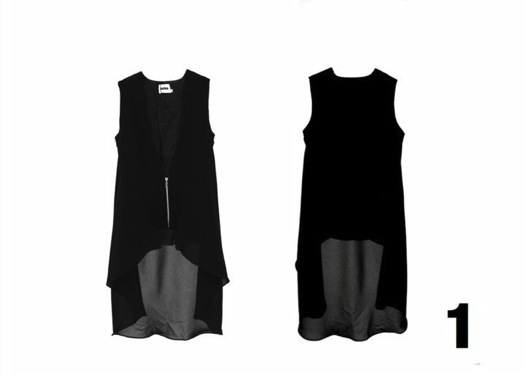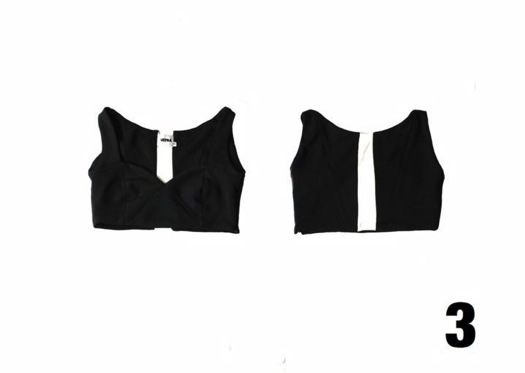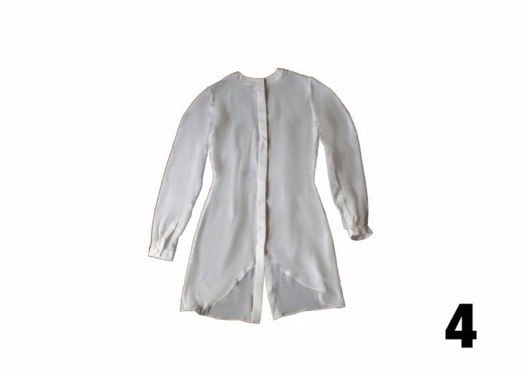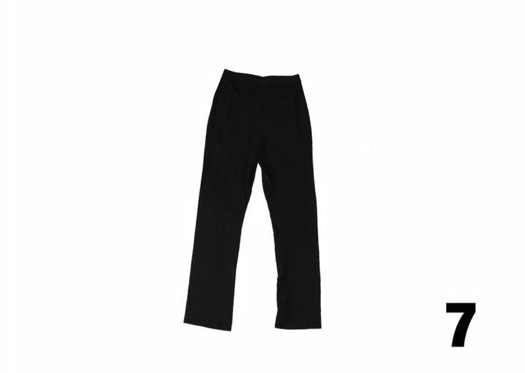
ULTRA designed a collection of 10 items that are intended to constitute an entire wardrobe for a year. Photos: ULTRA
This month, Shanghai-based Amena Schlaikjer, founder of The Wellness Works, an organization promoting healthy urban lifestyles, is donating almost her entire wardrobe to charity. Nearly 90 percent of a highly fashionable collection will be emptied except for a coat and accessories. In its place, for the next 365 days, Schlaikjer’s closet will be composed of just ten items. Some are expected staples: a pair of pants, a blouse. Others are strikingly versatile: a jacket that turns into a vest; a long coat that unzips into a skirt and shirt. Part of the Malaysian ULTRA fashion line, all ten items in the collection are made of sustainable materials like organic cotton, bamboo and biodegradable Tencel.
“I'm really relieved, actually,” Schlaikjer told me over Skype. What initially began as “a selfish way to declutter” is becoming a joint project in sustainable living among We Are ULTRA, one of Asia's leading sustainability collectives; LOHAS magazine, which focuses on health and wellness in China; Greenovate, a China-based sustainability organization; and Schlaikjer's Wellness Works. At the end of the year, Schlaikjer and others participating in “The Ultra 10 Challenge” will return their outfits to be repurposed and reused, and they'll have the option to buy a newly designed set on discount. According to Schlaikjer, it's the first such swap/donate event in China, and it's already reached its maximum of 200 participants.

Based in Kuala Lumpur and Shanghai, We Are ULTRA was founded in 2009 by Tengku Jamidah, a business development manager at a luxury watch company. Motivated to take up environmental causes after the birth of her daughter, she partnered with Anita Hawkins, a writer and creative consultant in Malaysia, to set up The Ultra Ultra, a blog that explores issues of sustainability with a focus on aesthetics and design.
The women soon noticed gaps in their coverage. Sustainable, attractive, commercially viable products were difficult to find, or simply didn't exist. The two founded an organic bath goods line and began importing sustainable products into Malaysia. They soon connected with the Malaysian fashion designers Jonathan Liang and Tengku Syahmi, who had already been developing an interest in sustainability.
Today, the four are at the core of We Are ULTRA. Made of such materials as recycled polyester, bamboo and fish skin, their products have chic minimal lines and neutral palettes. “ULTRA is a breath of fresh air,” Schlaikjer explained of the group's novel approach in a region where sustainability and contemporary design rarely mix. “They're doing things with conscience, and they're doing things mainstream.”

But good design doesn't exist in a vacuum, and neither do its connoisseurs. “We want the public to be invested in the development and growth of the brand,” Tengku Jamidah said. “We want them to feel connected emotionally and feel actively involved.” In addition to their blog, they maintain active accounts on Twitter, Flickr and Facebook. They communicate regularly with supporters and maintain full transparency about their sustainable practices and where they might fall short (for instance in certification, which can be costly for a new label).
The open community building works: they recently raised nearly $10,000 on Kickstarter to mount a show at Tranoi during Paris Fashion Week, using incentives like a selection of Asian indie music and a designer sketchbook. (I made a small donation and as a result received a credit on their website.) They have also exhibited in Hong Kong and Colombo, Sri Lanka. And now, they're building the ULTRA Workshop in Kuala Lumpur, an atelier for the creation of their designs that they plan to rent out to emerging fashion designers, and the ULTRA Shop, an exhibition of sustainable products.

“Sustainable fashion is a definition that we're constantly learning to appreciate and interpret,” Hawkins, who now lives in Shanghai, explained. “It started off with our understanding that it's mostly in materials and how they're produced. We got people to come on board, to write for our blog. We worked with a few artists for a few events and profiled the people we've worked with. We wanted a way to feed off each other and create things that could be worthwhile."
Their name underlines their growing popularity. As the collective was forming, Tengku Jamidah and Hawkins were attending a Halloween party, and Hawkins had dressed as Ultra Man, a popular Japanese television hero powered by solar energy. Inspiration for the name of their group struck. "We have those extreme personalities,” Tengku Jamidah explained. “Either we go all the way or we do nothing at all." The group’s new collection launches on May 21 in Shanghai and on the web.


Comments [9]
05.17.11
03:09
05.17.11
10:47
05.18.11
11:11
This may not compensate for the cost of a high fashion item, but if we all bought less, we may find we can afford more on each piece. Not only will mean we are shopping with a more sustainable consciousness, but it will also hopefully (and eventually) shift more consumers away from buying cheap clothing made by "slave" or child labor.
05.18.11
03:05
05.18.11
06:10
http://www.littlebrowndress.com/
http://www.theuniformproject.com/
where the participant tries to wear the same dress everyday. These are all good ways to test new dressing practices and show that another way of doing things is genuinely possible. Its the (more often social) constraints that they show up in the process that are interesting, because its those that are the real barrier to wider takeup. For this project to go further than previous ones I think it would be valuable to take up the challenge of these barriers to change. Sure its nice to do the experiment, but what are the wider challenges to making this kind of practice a general norm rather than a pleasant oddity? Rather than treat this as a one-off project, what will the next phase of its dissemination entail?
There is also some interesting counterpoints to this. I think eco-conscious fashion designers too often fall into the trap of thinking conspicuous consumption is the (only) enemy. Most of the energy is directed by a naive eco-design principle; i.e. reduce the material impact of each unit product. This project goes beyond this somewhat in also trying to reduce the amount of products (clashing somewhat with the ideology of 'self expression') but it still fails to engage in what I think may be more significant areas for fashion designers to explore.
The first is that the biggest impact of fashion is in the cleaning (water, energy, chemicals). The ultimate challenge for fashion designers perhaps should be help reduce the need/desire/habit of cleaning clothes more than is necessary. A lot of this of course comes down to social conceptions of cleanliness, odour, etc. but I would like to know what designers could come up with that would seduce people into new, less intense habits of cleaning.
The other thing to be aware of is that clothes are not just signs, they are equipment for doing things in. The clothes that you design therefore are suited to particular practices that may be more or less sustainable than others. Clothes will restrict or enable movement, provide protection from heat/cold/dirt/piercing etc, offer additional 'hands' via pockets etc etc. What you can do with clothes, what activities are easier or harder, should be as much a object of concern as what they look like.
In a sense I'm suggesting that fashion designers should be working towards redesigning entire practices, not just doing low-fat haute couture.
05.18.11
09:26
http://sixitemsorless.com/
http://freefashionchallenge.com/
ULTRA 10 is not a one-off project but rather a continuation of our exploration of the possibilities. We are hoping to continue to explore further applications, such as modular pieces and virtual tailoring. Yes, to minimise material impact, but also to attempt redesigning the way we practice fashion/production as you say.
In our journey we've come across these questions you pose and it is always good to hear them again. The cleaning factor is one that we do get stuck on, and any proposals to shift that 'habit of cleaning' mindset through design would be fantastic. :)
Am looking forward to this becoming a commercial possibility:
http://www.wired.com/gadgetlab/2010/11/cheap-carbon-cloth-can-zap-toxins-kill-bacteria/
Or when these exist for the home:
http://www.psfk.com/2010/11/dry-cleaner-for-the-closet.html
We have found this list quite helpful in shaping our direction:
http://britishfashioncouncil.com/uploads/media/290/19862.pdf
- it's an interesting one, in that it gives a good overview as to what many eco-conscious designers are currently thinking about and trying to address.
05.19.11
02:20
05.24.11
01:47
To answer your questions on durability and ease of combination, our recycled jersey is breathable and of high quality. It takes much wash to wear it out. As the base colour palette uses neutral tones, they work well when under or overlaying. Many of them are also designed to be modular, with detachable skirts, tops and sleeves.
05.31.11
07:40